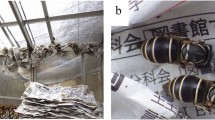Abstract
The effect of group size on behavioral parameters of the Oriental hornet,Vespa orientalis, was assessed experimentally under laboratory conditions. Hornet groups of various sizes (ranging from 1 to 100 individuals per group) comprised of young individuals (0–24 hr of age) devoid of a queen were placed in artificial breeding boxes (ABBs). The following three quantitative parameters were evaluated: the amount and rate of building as a function of the number of hornets in the group, the rate of oviposition as, related to group size and the longevity of hornets as a function of their group size. The probability for the occurrence of these events was similarly considered and additional behavioral parameters were only assessed qualitatively.
Results of this investigation revealed a relation between the three mentioned quantitative behavioral parameters and the number of hornets per group. The number of hornets per group was positively related to the extent of building, the number of cells built by a group is\(2\pi \sqrt {group size} \), but negatively related to the rate of building. As for the delay of building, a non-monotone relation was found. The relation between number of hornets per group and the oviposition delay was found to be non-monotone; the number of hornets per group and their longevity were found to be inversely related.
Discrepanices were recorded on the very small (1–2 individuals) or very large (100 individuals) hornet groups.
Similar content being viewed by others
References
Box, G. E. P. and D. R. Cox. 1964. An analysis of transformation.J. Royal. statis. Soc. 26(B), 211–252.
Brian, M. V. 1983.Social Insects, Ecology and Behavioral Biology. Chapman and Hall, New York.
Darchen, R. 1957. La rein d'Apis mellifera, les ouvrieres pondeuses et les constructions cirieres.Insectes Sociaux 4, 321–325.
Grassé, P. P. 1946. Societés et effect de groupe.Experientia 2, 77–82.
Grassé, P. P. and R. Chauvin. 1944. L'effect de groupe et la survie de neutres dans les societes d'insectes.Rev. Scientifique 82, 461–464.
Ishay, J. 1964. Observations sur la biologie de la Guêpe orientaleVespa orientalis en Israel.Insectes Sociaux 11, 193–206.
Ishay, J. 1973. The influence of colling and queen pheromone on cell building and nest architecture byVespa orientalis (Vespinae, Hymenoptera).Insects Sociaux 20, 243–252.
Ishay, J. S., 1975. Cast, determination by social wasps: cell size and building behavior.Anim. Behav. 23, 425–431.
Ishay, J. S., K. Zusman, V. Paniry, E. Rosenzweig and M. B. Brown. 1980. Longevity of hornet workers exposed to different light, diet and crowing conditions.Entomol. Gener. 6, 39–47.
Ishay, J. S., A. B. Afek and M. B. Brown. 1982. Allopurinol and theophylline: their effect on longevity, fertility and behavior of hornets kept under different light and crowding conditions.Comp. Biochem. Physiol. 73C, 57–65.
Ishay, J. S., E. Rosenzweig and H. Pechhacker. 1986. Comb-building by workers ofVespa crabro V. orientalis andParavespula germanica (Hymenoptera, Vespinae) Interaction between worker groups of these species while engaged in various social tasks.Monitore Zool. Italiano N.S. 20, 31–51.
Ishay, J. S., A. H. Abes, H. L. Chernobrov, I. Ishay and A. Ben-Shalom. 1991. Electrical properties of the Oriental hornet (Vespa orientalis) cuticle.Comp. Biochem. Physiol. 100, 233–271.
Iwata, K. 1971.Evolution of Instinct. Mano Shoten, Kanagawa Prefecture, Japan.
Janet, C. 1895. Études sur les fourmis, les guêpes et les abeilles 9th note, surVespa crabro L. Histoire d'un nid depuis son orgine.Mem. Soc. Zool. Fc. 8, 1–140.
Martin, P. 1963. Die Steurung der Volksteilung beim Schwarmen der Bienen, Zugleich ein Beitrag zum Problem der Wanderschwarme.Insectes Sociaux 10, 13–42.
Matsuura, M. 1983. Preliminary report on the polygynous colonies ofVespa affinis indosinensis (Hymenoptera, Vespidae) in Sumatra.Kontyu 51, 80–82.
Matsuura, M. 1990. Nesting habits. InBiology of the Vespinae Wasps, M. Matsuura and S. Yamane (eds). Springer-Verlag, Berlin.
Parmet, Y. 1991. Box-Cox power transformation family in thet-distribution error model. M.Sc. Thesis, Tel-Aviv University.
Ross, K. G. 1982. A typical yellowjacket nests initiated in the laboratory (Hymenoptera, Vespidae).J. Kans. Entomol. Soc. 55, 563–567.
Sokal, R. R. and F. J. Roholf. 1981.Biometry 2nd edn. W. H. Freeman, New York.
Watkins, J. F. and C. W. Rettenmeyer. 1967. Effect of army ant queens on longevity of their workers (Formicidae: Dorylinae).Psyche, Cambridge 74, 228–233.
Author information
Authors and Affiliations
Rights and permissions
About this article
Cite this article
Ishay, J.S., Abes, A.H., Chernobrov, H.L. et al. Building activity and longevity of queenless groups of the Oriental hornet,Vespa orientalis . Bltn Mathcal Biology 57, 441–460 (1995). https://doi.org/10.1007/BF02460634
Received:
Accepted:
Issue Date:
DOI: https://doi.org/10.1007/BF02460634




